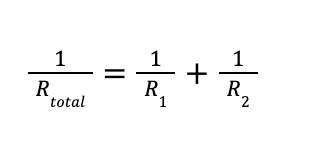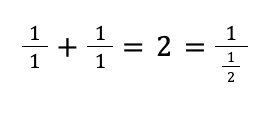“One Oreo McFlurry, please.” I hand the cashier my card, take the receipt, and then wait. “Pull up to Window 3, sir, to get your order.” Stretching out in front of me are four windows in a series, one after the other, after the other. But I can't get to the third window without waiting for the car at window two to finish. The system is inane. Putting their windows in series, one after another isn't helping this McDonald's with their delivery process.
And that, essentially, is a resistor. Each additional window adds more friction to the drive-through process. Resistors, just like these windows, resist the flow of electrons (or cars in this example). Stacking resistors one after the other makes the total resistance higher.

McDonald's could set up their drive-through differently. Having three parallel rows of cars would speed up the delivery process, with the total resistance of this setup being less the resistance of any single lane. And so:

While simply adding resistances in series makes some intuitive sense, understanding what happens when they are in parallel is harder. In STEM, your most powerful tool to test things are via limiting cases. Imagine, for example, that each lane in a drive-through (each resistor) moves equally fast. Having two lanes means that the cars would be split between them, and you could get your meal in half the time. A quick check:
 Likewise, if one lane moved incredibly fast (no resistance), we would expect everyone to get their food immediately. And if one lane had a brick wall (infinite resistance), the drive-through would revert to a single lane. If you forget equations on exam day, piecing together what their form should be based on the behavior in these defining cases can be a lifesaver.
Likewise, if one lane moved incredibly fast (no resistance), we would expect everyone to get their food immediately. And if one lane had a brick wall (infinite resistance), the drive-through would revert to a single lane. If you forget equations on exam day, piecing together what their form should be based on the behavior in these defining cases can be a lifesaver.

Additional drive-through features could shift this process even more. Occasionally, there could be someone ushering cars through the drive through. Perhaps this usher is the equivalent of an inductor - let’s test it! If cars suddenly started trying to go through the drive through at 50 miles an hour, the usher would tell them to slow down. And if the cars suddenly stopped moving at all, he would convince them to move forward. If you had multiple ushers, one after the other, these people would increase the consistency of the car speed. But if you had a lane with no usher (inductor), the car speed would be variable. With that logic, the usher can be definitively considered an inductor, resisting changes to current and adding in series reciprocally in parallel.

While this example is fantastical, there are a few key points to take away:
- Grounding abstract physics in real life makes it more intuitive.
- Looking at edge cases is crucial to understanding behavior.
- Random examples like this can test your knowledge. (Bonus: what would a capacitor be in this drive-through metaphor?)


Comments